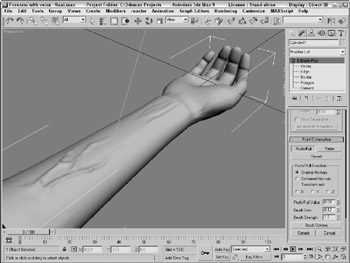Using the Deformation Brushes
The Push/Pull brush may be used to pull vertices away from the object surface or to indent the surface by moving the surface toward the object's center. The difference is determined by the Push/Pull value. Positive values pull vertices, and negative values push vertices.
| Tip | Holding down the Alt key while dragging reverses the direction of the Push/Pull brush, causing a pull brush to push and vice versa. |
Controlling the deformation direction
By default, dragging over vertices with the Push/Pull brush causes the affected vertices to be moved inward or outward along their normals. If you drag over the same vertices several times, they are still deformed using the original face normals.
The Deformed Normals option causes the vertices to be moved in the direction of the normal as the normals are deformed. Using the Original Normals option causes the deformed area to rise from the surface like a hill with a gradual increasing height. The Deformed Normals option causes the deformed area to bubble out from the surface.
The Transform Axis option causes the vertices to be moved in the direction of the selected transform axis. This option is useful if you want to skew or shift the deformed area.
Limiting the deformation
If a subobject selection exists, then the vertices that are moved are limited to the subobject area that is selected. You can use this to your advantage if you want to make sure that only a certain area is deformed.
Committing any changes
After you make some deformation changes, the Commit and Cancel buttons become active. Pressing the Commit button makes the changes permanent, which means that you can no longer return the vertices to their original location with the Revert brush. The Cancel button rejects all the recent deformation changes.
Using the Relax and Revert brushes
The Relax brush provides a much more subtle change. It moves vertices that are too close together farther apart, causing a general smoothing of any sharp points. It works the same way as the Relax feature for the Editable Poly object and the Relax modifier.
The Revert brush is used to return to their original position any vertices that have moved. For example, if you pushed and pulled several vertices, the Revert brush can undo all of these changes for the area under the brush cursor.
| Tip | Holding down the Ctrl key while dragging with the Push/Pull brush lets you temporarily access the Revert brush. |
Tutorial: Adding veins to a forearm
The Paint Deformation feature is very useful in adding surface details to organic objects such as the veins of a forearm.
To add veins to a forearm object, follow these steps:
-
Open the
 Forearm with veins.max file from the Chap 16 directory on the DVD.
Forearm with veins.max file from the Chap 16 directory on the DVD.The polygons that make up the forearm object have been selected and tessellated to increase its resolution.
-
With the forearm object selected, open the Modify panel and in the Paint Deformation rollout, click the Relax button. Set the Brush Size to 1.0, and drag over the entire forearm.
This smoothes out some of the vertical lines that run along the forearm.
-
Click the Push/Pull button, and set the Push/Pull Value to 0.15, the Brush Size to 0.08, and the Brush Strength to 0.5. Then draw in some veins extending from the elbow toward the hand.
-
Lower the Brush Strength value to 0.25, and extend the vein further down the arm. Then drop the Brush Strength to 0.1, and finish the veins.
-
With the Push/Pull brush still selected, hold down the Alt key and drag near the wrist to indent the surface around the area where the hand tendons are located.
Figure 16.4 shows the resulting forearm.

Figure 16.4: The Paint Deformation brushes are helpful in painting on raised and indented surface features